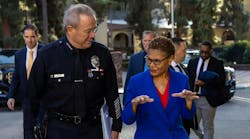More minorities are applying for jobs as Pittsburgh police officers and firefighters, but their ranks among those in uniform continue to dwindle, a review by the City Controller's Office found.
"We're seeing recruits drop off through the testing process," said Controller Michael Lamb, who released the audit Tuesday.
Lamb said the city should use federal workforce investment money to pay for more training available at Community College of Allegheny County to help recruits pass the necessary tests to become officers, firefighters and paramedics.
When asked for comment, mayoral spokeswoman Marissa Doyle sent a web link to the city's written response to the audit. It explains a scorecard the city uses to track female and minority employment and says the city has been successful in increasing minority applications for public safety jobs.
Minority applicants for all city jobs increased from 205 in 2005 to 1,757 last year, Lamb's audit shows. Minority applicants for police officer shot up from 109 in 2005 to 442 in 2011.
"The recruitment appears to have improved, but how does that translate into hiring practices?" asked Tara Simmons, vice president of the South Side-based Women and Girls Foundation, which helped pay for a 2009 pay-equity study by Evergreen Solutions, a Florida company the city hired.
Lamb and others noted some recent police training classes contained only one or two minorities.
"One African-American man and one African-American woman certainly does not mean that police force hiring is diverse," Simmons said.
The number of minority employees in public safety departments dropped from 17 percent in 2006 to 15 percent at the end of last year, Lamb's report found.
Tim Stevens, chairman of the Black Political Empowerment Project, called it an example of the "re-whitening of the police force."
"The numbers clearly counteract the argument that no black people want to become police officers," he said. "With that number of black people interested, we must ask why there's only one in a class."
Minorities made up 26 percent of all city hires in 2012 -- an improvement from 24 percent in 2005 -- but only 11 percent of the full-time hires were minorities. The city has about 3,100 employees.
Carl Redwood of the Hill District, a community activist and founder of the One Hill Consensus Group, said he sees no real political pressure to change.
"The bottom line is the black population in the city is more than 28 percent. The percentage of the city employees should mirror the population at least," he said. "We're nowhere near that goal."
City Council asked Lamb's office a year ago Wednesday to review the city's performance since the Evergreen study. Evergreen made recommendations to review job titles, increase training and opportunities for workers and implement a system to improve minority representation.
Copyright 2013 - The Pittsburgh Tribune-Review
McClatchy-Tribune News Service


